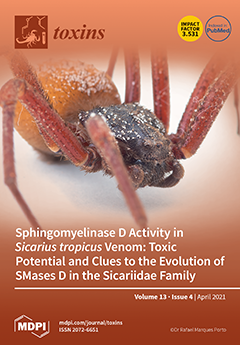Ergotism is a common and increasing problem in Saskatchewan’s livestock. Chronic exposure to low concentrations of ergot alkaloids is known to cause severe arterial vasoconstriction and gangrene through the activation of adrenergic and serotonergic receptors on vascular smooth muscles. The acute vascular effects of a single oral dose with high-level exposure to ergot alkaloids remain unknown and are examined in this study. This study had two main objectives; the first was to evaluate the role of α
1-adrenergic receptors in mediating the acute vasocontractile response after single-dose exposure in sheep. The second was to examine whether terazosin (TE) could abolish the vascular contractile effects of ergot alkaloids. Twelve adult female sheep were randomly placed into control and exposure groups (
n = 6/group). Ergot sclerotia were collected and finely ground. The concentrations of six ergot alkaloids (ergocornine, ergocristine, ergocryptine, ergometrine, ergosine, and ergotamine) were determined using HPLC/MS at Prairie Diagnostic Services Inc., (Saskatoon, SK, Canada). Each ewe within the treatment group received a single oral treatment of ground ergot sclerotia at a dose of 600 µg/kg BW (total ergot) while each ewe in the control group received water. Animals were euthanized 12 h after the treatment, and the pedal artery (dorsal metatarsal III artery) from the left hind limb from each animal was carefully dissected and mounted in an isolated tissue bath. The vascular contractile response to phenylephrine (PE) (α
1-adrenergic agonist) was compared between the two groups before and after TE (α
1-adrenergic antagonist) treatment. Acute exposure to ergot alkaloids resulted in a 38% increase in vascular sensitivity to PE compared to control (Ctl EC
50 = 1.74 × 10
−6 M; Exp EC
50 = 1.079 × 10
−6 M,
p = 0.046). TE treatment resulted in a significant dose-dependent increase in EC
50 in both exposure and control groups (
p < 0.05 for all treatments). Surprisingly, TE effect was significantly more pronounced in the ergot exposed group compared to the control group at two of the three concentrations of TE (TE 30 nM,
p = 0.36; TE 100 nM,
p < 0.001; TE 300 nM,
p < 0.001). Similar to chronic exposure, acute exposure to ergot alkaloids results in increased vascular sensitivity to PE. TE is a more potent dose-dependent antagonist for the PE contractile response in sheep exposed to ergot compared to the control group. This study may indicate that the dry gangrene seen in sheep, and likely other species, might be related to the activation of α
1-adrenergic receptor. This effect may be reversed using TE, especially at early stages of the disease before cell death occurs. This study may also indicate that acute-single dose exposure scenario may be useful in the study of vascular effects of ergot alkaloids.
Full article






